FS S5850-48T4Q Internal Hardware Overview
Here is the switch on its side. We can see the ports on the left and the power supplies on the right.
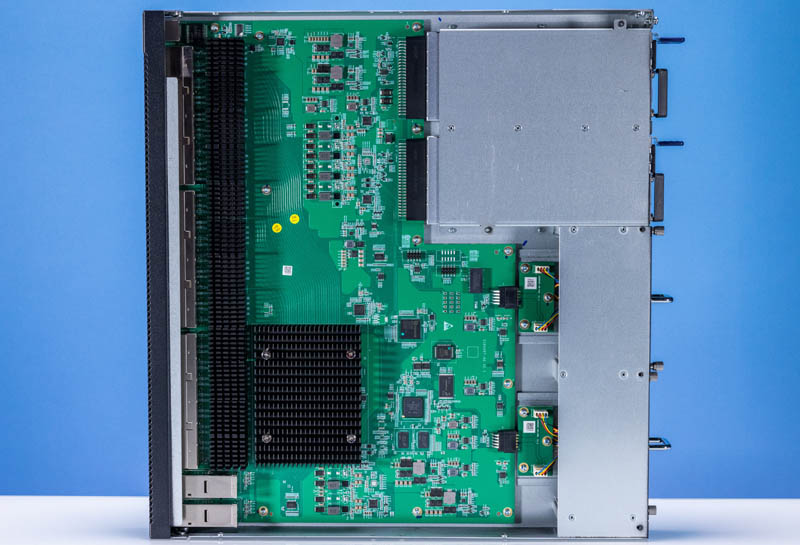
The front of the switch is mostly made up of large heatsinks, and there are areas where the switch PCB inside is relatively bare. One other important point is that in many higher-end switches we see the switch on a PCB with its ports, then daughtercards for management processors, fan controllers, BMCs, or other parts. Here, everything except the fan module boards are on the same PCB.
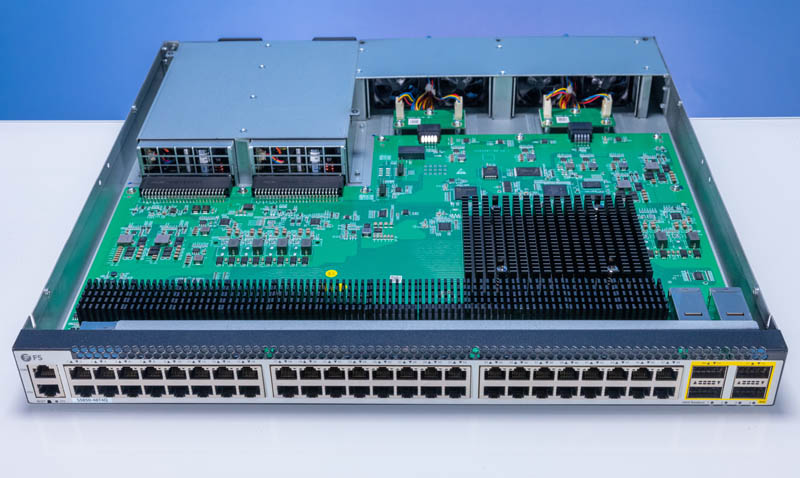
Here is a quick look at the switch chip heatsink.
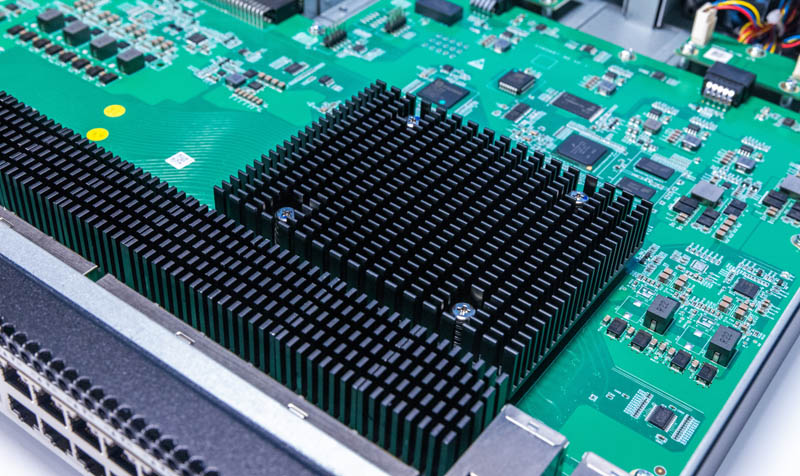
Here are the key specs. We will simply say if you want to find a specific feature, you should check out the documentation for the switch as there are so many different needs it is hard to cover them all.
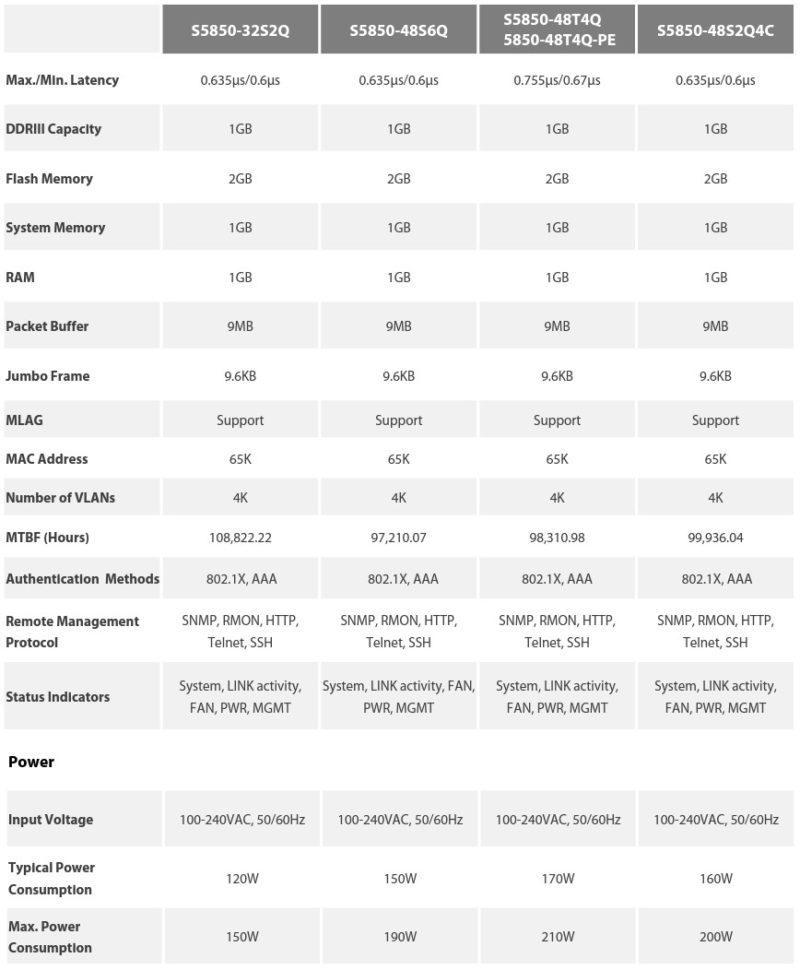
Here is another look at the heatsink. The fins are actually oriented at a 90-degree angle from the 10Gbase-T PHY heatsink fins. That is just different.
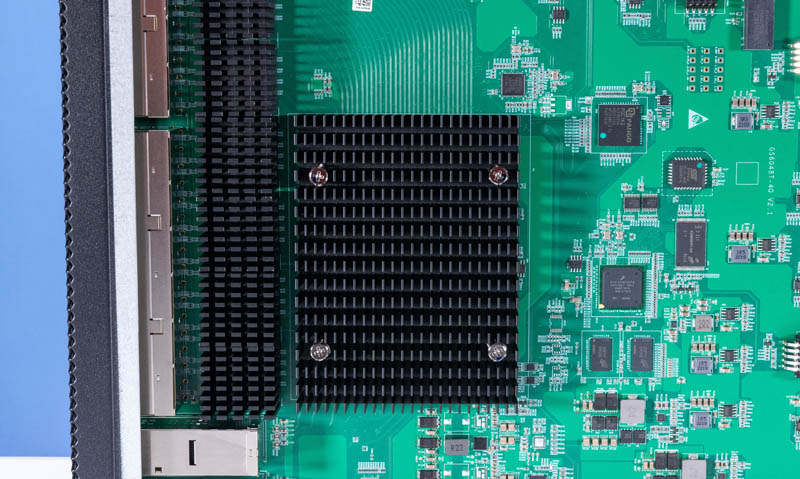
Those PHY heatsinks are very large. Much larger than we see on SFP+ cages from this era of switch.
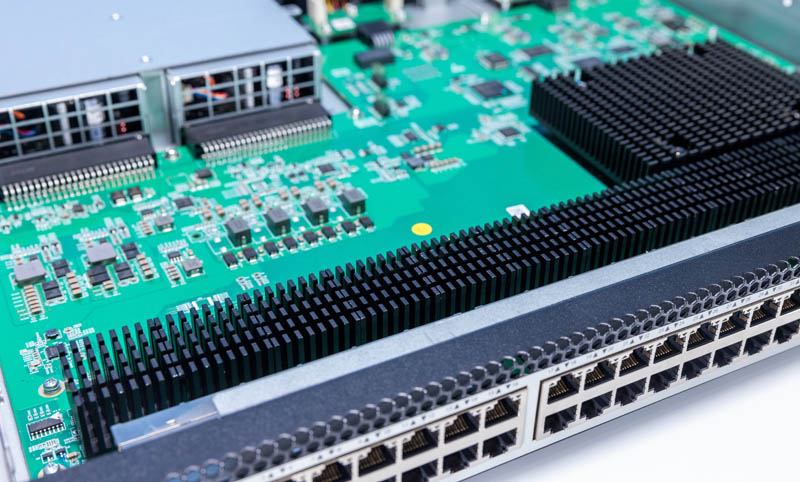
As far as the chipset, we have a Pango PGC1KG that looks like a CPLD. There is Micron DRAM and storage likely for the Freescale P1010NSE5DFB controller. That is a 32-bit Arm CPU so it is a relatively slow management processor.
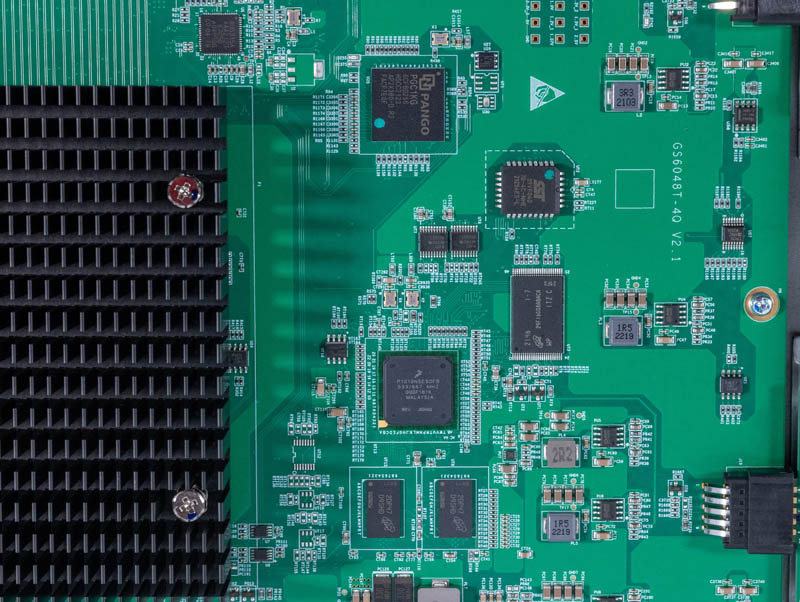
Here is a look at the area next to the power supplies.
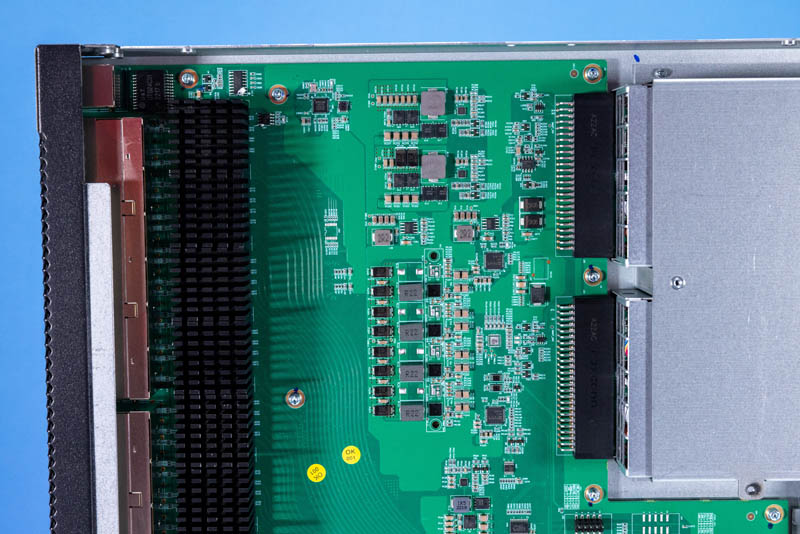
Here is a look at the fan module headers from inside.
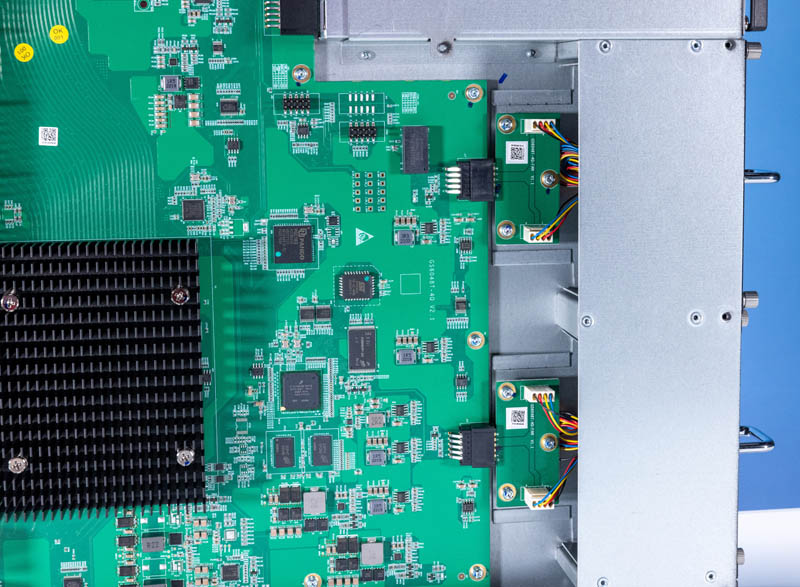
This is a relatively low-speed switch compared to others like the FS N8560-32C 32x 100GbE switch we reviewed. That lets it be simpler in design while also being lower cost. It is evident this is a different class of switch from the N8560-32C.
Next, let us get to our management, power consumption, and final words.
FS S5850-48T4Q Management
The switch itself has a CLI, but the perhaps more interesting one is the web interface. Many of FS.com’s switches do not have web management interfaces, but this one does.
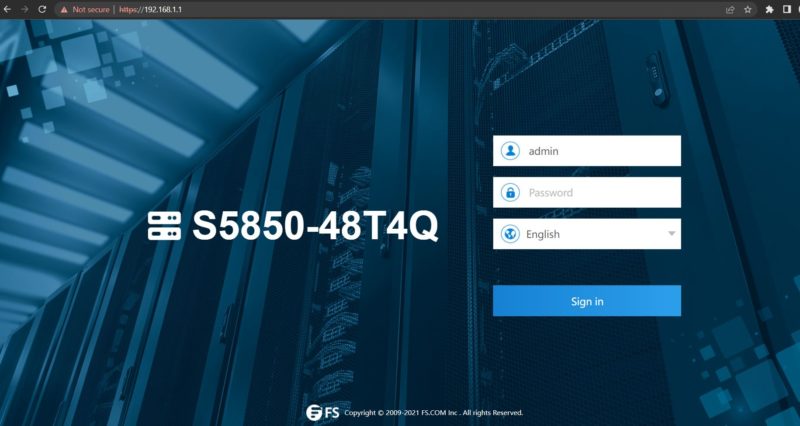
One of the first things that we were very surprised by was the login. It was admin/ admin. If you saw our Why Your Favorite Default Passwords Are Changing piece, you would expect there to either be a randomized password or a prompt to immediately change the password, but there was not. We could just use admin/ admin. As a result, if you live in California or other jurisdictions with similar rules in place for years, this would not be compliant.
The web management interface is an interesting one, but there is something that was immediately noticeable. It is slow, even if it looks approachable for novice admins.
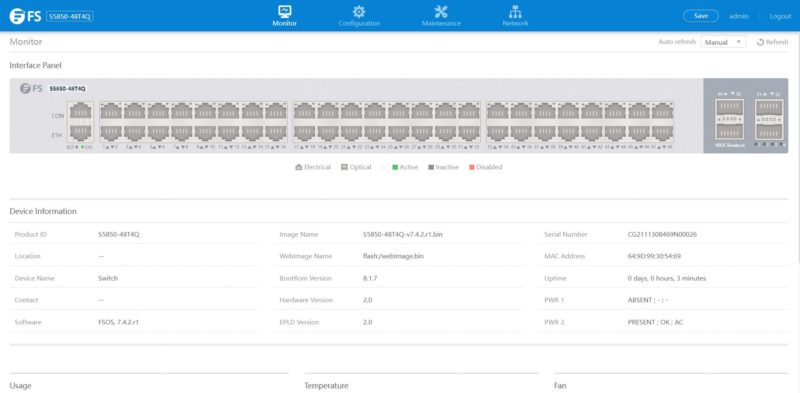
There are a decent number of features available beyond just simple VLANs.
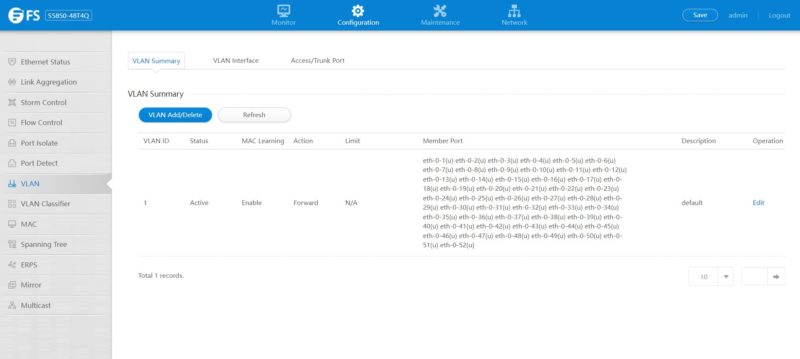
Here is a quick list we found of the advanced features that the switch has. Still, there are more but the listings of features these days take a page or more of three-column data sheets. Our suggestion is to check if this switch supports the features you need.
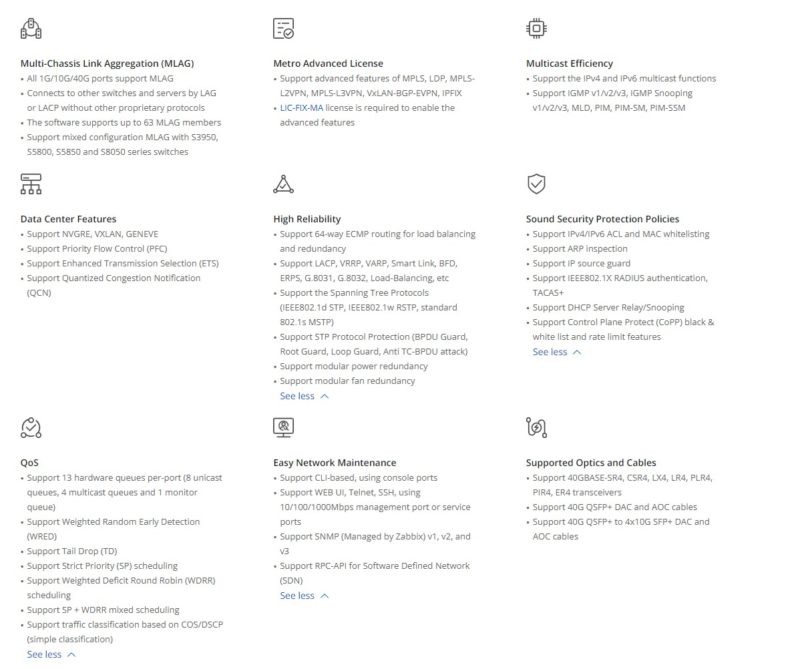
Next, let us get to power consumption before getting to our final words.
FS S5850-48T4Q Power Consumption
The power on this unit is interesting. At idle, we could get this switch down to around 95W. That is down from around 113W when the switch starts up and is in higher-fan modes.

Typical power consumption is rated at 170W. Maximum at 210W. Depending on the port configurations/ speeds, that gives us a range of 95W to 210W.
Final Words
Overall the FS S5850-48T4Q is an interesting switch. The reason it is interesting is not that it has some sort of amazingly advanced feature set. Instead, it is amazing because of the pricing. It is $4,729 at the time of this writing, and in stock. These days, switches are often hard to find, so a reasonably priced 10Gbase-T switch is a decent deal.
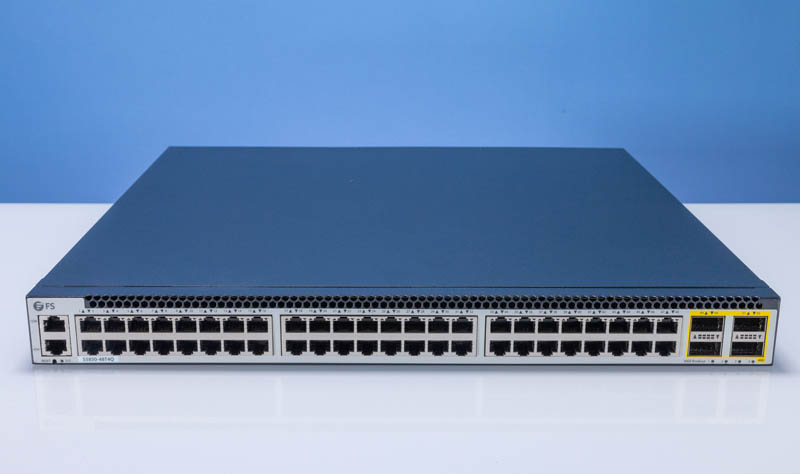
With that said, this feels like a lower-cost solution in FS’s portfolio. Although it is a L3 switch, there is little information on the company’s site as it normally does with its Broadcom switches.




Nothing makes me question product quality like a MTBF with a precision down to a hundredth of an hour at 108,822.22 hours.
FS hardware always feels sketchy, and this thing is no exception. Everything they build seems like a triumph of gray market sourcing coupled with a casual flaunting of regulatory compliance.
Cool to take a peek inside though, even if I’m against the product. Seeing switches popped open is always a treat.
These reviews leave much to be desired. The earlier reviews for switches would put them through their paces, do performance testing, remove heatsinks so that we could look at the Switch NPU/CPU.
Nowadays the reviews read more like product placement or looking at the manufacturer’s brochures :(
The fact that STH is considering $4800 “cheap” ($100/port) is nuts. In 2022, the fact that any 10GbE, especially a non-MultiGbE and/or PoE one @$100/port is just stupid.
This reeks of price fixing. 10GbE is commodity hardware at this point, it should be throwaway chips in every motherboard and edge device. The fact that it isn’t after 3 decades on the market, and almost a decade on the market with faster alternatives pushing it out of the DC space makes me feel like it’s been artificially price inflated.
The memory companies have been sued multiple times for artificially high pricing. Why is nobody looking at the networking companies for the same thing?
While I agree with the above, of note is the alleged latency. I’d like to see that tested.
That’s among the faster switches the big boys offer at considerably higher prices. <700ns isn’t anything to scoff at these days.
Arista’s 7050sx3 is 800+. And I’d be willing to bet that’s not the case across 10/40 interfaces.
If your normal switch vendor has got yearlong lead times I’d say $4800 is what you can price at. There aren’t many chip vendors so I’d get why these are still not cheaper.
I’m more looking at the review comments around passwords, slow web management, and no nbaset and I’m asking why all the FS reviews are fivestar without mentioning those.
Lack of multigig support surely leaves this dead in the water for edge, unless you are running a very niche case where every device has 10gbe support and the infrastructure in place to support it.
You wouldn’t want to waste $100 ports at gigabit speeds.